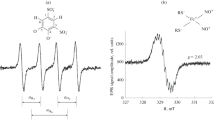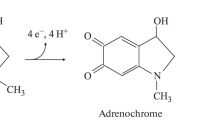Abstract
The physiologically active metal ions with fixed valence Ca2+ and Mg2+ were shown to accelerate epinephrine autoxidation at an alkaline pH, which proceeds via the known quinoid pathway and is accompanied by the generation of reactive oxygen species. A higher efficiency was observed for Ca2+ ions compared with Mg2+ ions. The activation of epinephrine autoxidation was evident from a decrease in the time of the initiation of the chain reaction to begin (i.e., the reaction lag) and an increase in the rate of both oxygen uptake and the formation of adrenochrome. Based on the observed effects, Ca2+ and Mg2+ cations were assumed to have the potential to play a role in the free radical processes that are associated with redox reactions in the cell and can also modulate the effect of epinephrine in the organism its oxidation via the quinoid pathway.
Similar content being viewed by others
References
W. Bors, C. Michel, M. Saran, and E. Lengfelder, Biochim. Biophys. Acta 540 (1), 162 (1978).
A. Bindoli, M. P. Rigobello, and L. Galzigna, Toxicol. Lett. 48 (1), 3 (1989).
F. Marques, R. O. Duarte, J. J. Moura, and M. P. Bicho, Biopl. Signals 5, 275 (1996).
R. Alhasan and D. Njus, Anal. Biochem. 381 (1), 142 (2008).
P. Mucoz, S. Huenchuguala, I. Paris, and J. SeguraAguilar, Parkinsons Dis. 2012:920953 (2012). doi 10.1155/2012/920953
T. V. Sirota, Biomed. Khim. 61 (1), 115 (2015).
T. V. Sirota, Vopr. Med. Khim. 45 (3), 263 (1999).
T. V. Sirota, RF Patent 2144674 (2000).
T. V. Sirota, Biomed. Khim. 58 (1), 77 (2012).
T. V. Sirota, Biomed. Khim. 59 (4), 399 (2013).
Y. Fu, L. Buryanovskyy, and Z. Zhang, J. Biol. Chem. 283 (35), 23829 (2008).
A. F. Rump, J. Schierholz, R. Rosen, et al., Arzneimittelforschung 51 (12), 964 (2001).
V. M. Costa, R. Silva, L. M. Ferreira, et al., Chem. Res. Toxicol. 20 (8), 1183 (2007).
J. Smythies, A. De Iuliis, L. Zanatta and L. Galzigna, Neurotox. Res. 4 (1), 77 (2002).
K. Jomova and M. Valko, Toxicology 283 (2–3), 65 (2011).
T. V. Sirota, N. V. Lange, N. K. Kosjakova, et al., Curr. Topics Biophys. 24, 185 (2000).
T. V. Sirota, in Mitochondria in Pathology: Proc. AllRussia Working Conf. (Pushchino, 2001), pp. 113–115.
T. V. Sirota, N. V. Khunderyakova, and M. N. Kondrashova, in Metal Ions in Biology and Medicine: Proc. 7th Int. Symp. (St. Peterburg, 2002), pp. 495–497.
Bioorganometallics: Biomolecules, Labeling, Medicine, Ed. by G. Jaouen (Wiley, New York, 2005; Binom, Moscow, 2010).
A. V. Lebedev, M. V. Ivanova, A. A. Timoshin, and E. K. Ruuge, Biomed. Khim. 54 (6), 687 (2008).
A. V. Lebedev, M. V. Ivanova, A. A. Timoshin, and E. K. Ruuge, Chem. Phys. Chem. 8 (12), 1863 (2007).
T. V. Sirota, A. I. Miroshnikov, and K. N. Novikov, Biophysics (Moscow) 55 (6), 911 (2010).
H. P. Misra and I. Fridovich, J. Biol. Chem. 247, 3170 (1972).
A. V. Lebedev, M. V. Ivanova, and E. K. Ruuge, Biophysics (Moscow) 56 (2), 188 (2011).
A. V. Lebedev, M. V. Ivanova, A. A. Timoshin, and E. K. Ruuge, Biophysics (Moscow) 58 (1), 37 (2013).
W. L. Gabler, Res. Commun. Chem. Pathol. Pharmacol. 70 (2), 213 (1990).
H. Suzuki, M. J. Pabst and R. B. Johnston, Jr., J. Biol. Chem. 260 (6), 3635 (1985).
T. Yamashita and A. Someya, Biochim. Biophys. Acta 927 (3), 359 (1987).
L. Simchowitz, M. A. Foy and E. J. Cragoe, Jr., J. Biol. Chem. 265 (23), 13449 (1990).
S. Baez and J. Segura-Aguilar, J. Biochem. Mol. Med. 56 (1), 37 (1995).
J. Smythies, Neurotoxicol. Res. 4 (2), 147 (2002).
V. G. Kolpakov, Zh. Nevropatol. Psikhiatr. im. S.S. Korsakova 74 (8), 1254 (1974).
G. S. Behonick, M. J. Novak, E. W. Nealley, and S. L. Baskin, J. Appl. Toxicol. 21 (1) 15 (2001).
Author information
Authors and Affiliations
Corresponding author
Additional information
Original Russian Text © T.V. Sirota, 2016, published in Biofizika, 2016, Vol. 61, No. 1, pp. 22–27.
Rights and permissions
About this article
Cite this article
Sirota, T.V. The effect of fixed valence metal ions on the free radical process of epinephrine autoxidation. BIOPHYSICS 61, 17–21 (2016). https://doi.org/10.1134/S000635091601022X
Received:
Accepted:
Published:
Issue Date:
DOI: https://doi.org/10.1134/S000635091601022X




